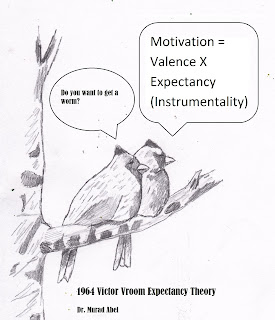Expectancy Theory postulates that a person will act
in a certain way and make particular decisions based upon what they expect the
results to be. Managers that desire to better
understand how to motivate employees should explore expectancy theory and its
practical use to boost performance. The theory has been used in a number of
companies and situations with great success. It is such a popular theory that
additional theories have been developed off of its seminal findings.
Victor Vroom indicated in his 1968 ground breaking
research that motivation can be fostered when employers ensure that rewards are
desired and tied directly to performance. His research showed through a number
of cases studies and experimental approaches that workers will perform better
when rewards are of significant value to employees. When the association of
effort and reward is too distant employees may have a hard time making the
connection and putting forward effort.
The Theory takes into account three main concepts
that include expectancy, instrumentality and valence. Expectancy is an employee’s
belief that additional effort will lead to higher levels of performance,
instrumentality is an employee’s belief that engaging in certain behaviors will
result in a reward, and valence is value of that reward to the employees.
Understanding how the formula works helps decision makers use policies,
procedures, leadership skills, compensation and succession planning as methods
of raising overall motivation.
Motivation
= Valence X Expectancy (Instrumentality)
Let us put this to an applied example. Bob is an
employee who has high self-esteem but has been suffering from an inability to
find a pathway to perform higher because the old manager believed that “having
a job” was reward enough. Bob is not stupid so he performs at a level comparable
to his co-workers so that he can keep the only reward the workplace is offering
“a job” but doesn’t put any more effort forward because there are no other
rewards to achieve (praise, recognition, compensation, promotion, etc…) Is Bob doomed to mediocre performance?
The company’s costs have been expanding causing
profits to plummet. The board of directors decides that new management is
necessary to achieve results. This new manager begins to adjust the
compensation structure, opportunities for promotion, and the ability of
employees to influence their workplace. Bob’s performance increases because he believes
that he has the ability to perform better (expectancy), trusts his new manager
enough to believe that his performance will be appropriately (instrumentality),
and finds the rewards of worthwhile value to motivate him (valence).
The great news is that it isn’t only Bob’s
performance that rises but also members of his team who see Bob receiving
rewards. They begin to adjust their behavior in emulation of Bobs so as to
receive similar benefits. Overtime, the new changes by the manager and the
development of employee performance expectations become embedded into the culture
raising standards and profits.
Before an organization decides to throw money into their
employee’s hands in the hope they will perform better, managers should be aware
that there are many factors that contribute to the success of Vroom’s
Expectancy Theory. Each component should be measured in multiple ways to
determine precisely where the problems and de-motivators reside within the
organization. Employees must have the
skills to perform better, believe they can perform better, and the right
organizational factors to encourage motivated behavior. The person,
environment, and the organizational design should align to make higher levels
of performance possible. It is a process
of continuous improvement.
Vroom, V. (1964). Work and motivation. New York: Wiley.
Kinicki, A. & Kreitner, R. (2009). Organizational behavior: key concepts,
skills, and best practices (Fourth Edition). USA: McGraw-Hill Company, Inc.
